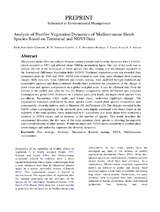Analysis of postfire vegetation dynamics of Mediterranean shrub species based on terrestrial and NDVI data
Autor
Hernández Clemente, Rocío
Navarro Cerrillo, Rafael M.
Hernández Bermejo, Esteban
Escuin Royo, S.
Kasimis, N.
Editor
SpringerLinkFecha
2009Materia
Fire ecologyDiversity
Succession
Remote sensing
NDVI
Mediterranean communities
METS:
Mostrar el registro METSPREMIS:
Mostrar el registro PREMISMetadatos
Mostrar el registro completo del ítemResumen
The present study offers an analysis of regeneration patterns and diversity dynamics after a wildfire, which occurred in 1993 and affected about 7000 ha in southern Spain. The aim of the work was to analyze the rule in the succession of shrub species after fire, relating it to the changes registered in the Normalized Difference Vegetation Index (NDVI). Fractional vegetation cover was recorded from permanent plots in 2000 and 2005. NDVI data related to each time were obtained from Landsat images. Both data sets, from fieldwork and remote sensing, were analyzed through statistical and quantitative analyses and then correlated. Results have permitted the description of the change in plant cover and species composition on a global and plot scale. It can be affirmed that, from the seventh to the twelfth year after the fire, the floristic composition within the burned area remained unchanged at a global level. However, on a smaller scale (plot level), the major shrub species, Ulex parviflorus, Rosmarinus officinalis, and Cistus clusii, underwent significant changes. The regeneration dynamics established by these species conditioned plant species composition and, consequently, diversity indexes such as Shannon (H) and Simpson (D). The changes recorded in the NDVI values corresponding to the surveyed plots were highly correlated with those found in the regrowth of the main species. Areas dominated by U. parviflorus in a senile phase were related to a decrease in NDVI values and an increase in the number of species. This result describes the successional dynamics; the dryness of the main colonizer shrub species is allowing the regrowth and re-establishment of other species. Within the study area, NDVI shows sensitivity to postfire plant cover changes and indirectly expresses the diversity dynamics.

